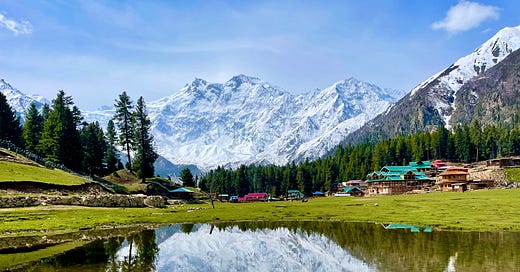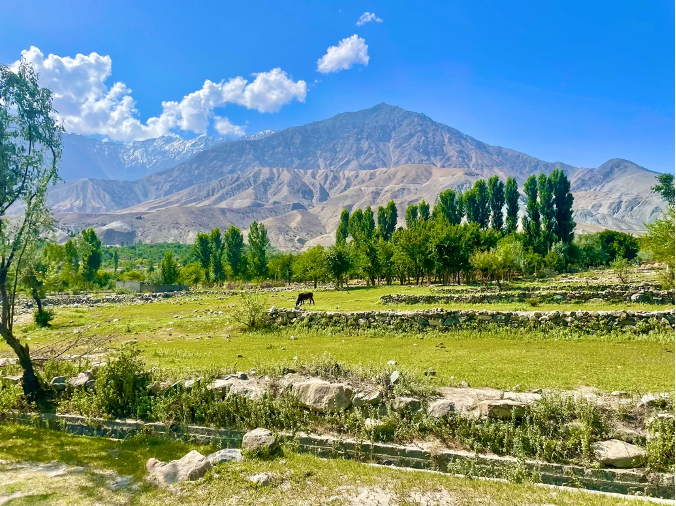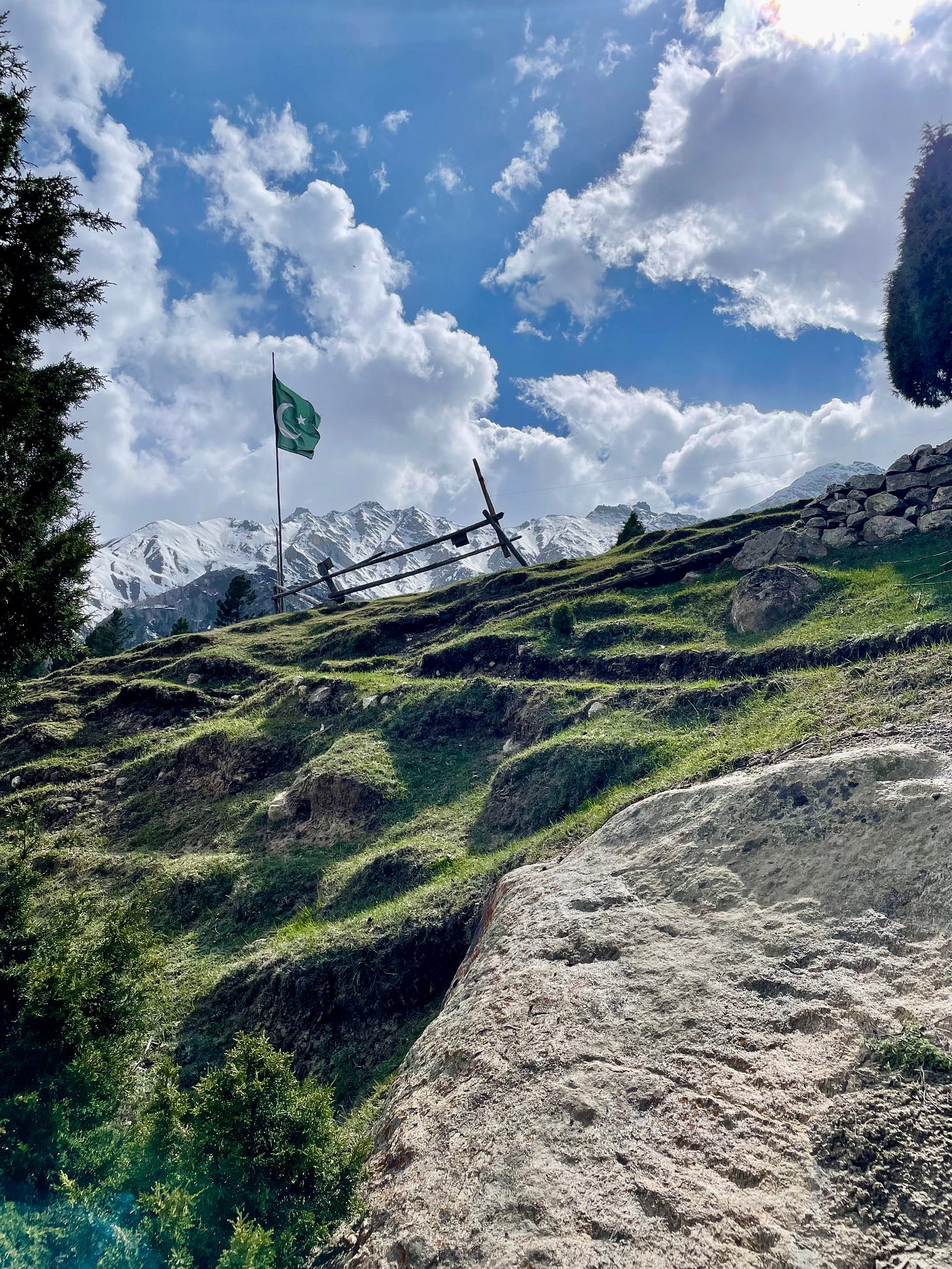I’m back in the States on the other side of a month spent in Pakistan, the land of my roots, my parents' birthplace, and the destination of my grandparents’ migration in the 1947 partitioning of the Indian subcontinent. I write from a post-travel haze where the veil of jet lag has yet to fully lift, my confused circadian rhythm sending body and spirit out of sync. My eyes blink open before dawn, where darkness melts into lavender. In the space between the woodpeckers’ hammering and the robin’s melody, my ears search for the rooster's crow and the koel’s two-note song.
I was a last minute tag along, joining my parents on a trip they had been dreaming about for ages. It’s been 20 years since they last visited their motherland, 10 years for me. We spent most of our time based in our home city of Lahore, punctuated by a weekend jaunt to the coastal city of Karachi and an epic week in Gilgit-Baltistan, a province in northern Pakistan where the Himalaya, Karakoram, and Hindu Kush mountain ranges converge and form a rugged masterpiece.
In a trip of such multitudes, it’s hard to know where the storytelling should begin. I flip through the pages of my journal, revisiting the reflections and anecdotes I recorded from the trip, looking for an image or quote to build a story around. I open a blank page and pen a one-sentence commandment: Start with the mountains.
It began 50 million years ago when the Indian subcontinent collided with Eurasia. Because the density of these two landmasses are so similar, instead of one plate sliding under another, they merged into a colossal upward eruption, resulting in the mountain range we call the Himalayas. The journey into Gilgit-Baltistan begins with an eight hour drive on the Karakoram Highway, snaking through barren terrain and jagged earth. I learned that the mountains are still growing, reaching upwards a few millimeters every year — a reminder that these rocks are alive.
Our first stop in Gilgit-Baltistan was a visit to Fairy Meadows, the gateway to Nanga Parbat, a snow capped Himalayan peak that is the second highest in Pakistan, ninth highest in the world. Getting to Fairy Meadows requires two hours of off-roading in a jeep to a mountainside village situated at 9515 feet above sea level. From there, it’s a two hour trek meandering on a narrow cliffside path to Fairy Meadows, 11,000 feet above sea level.
The trek was a challenge, the altitude and rocky incline demanding so much breath. My parents opted to complete the trek on horseback while I carried on by foot. Our guide, Ishfaq, a Fairy Meadows native who has lost count of the times he’s walked this trail in his life, sat with me on a trailside boulder where I stopped to catch my breath. In Urdu he tells me, “You’re trying to go too fast and too straight. The most peaceful way up the mountain is slowly and like a snake.” He demonstrates the proper way to trek, his hands folded behind his back like he’s on a leisurely stroll, as he calmly serpentines up the narrow path. “When you walk slowly,” he says, “you can also look up.” He points to a space between two trees where the bright white snow of distant peaks shines through.
Towards the end of the trail, Ishfaq’s sensei-like nature morphs into a boyish adventurer. “Let’s take a shortcut,” he says. Before I can consent, he scrambles up a vertical incline. I take the deepest breath the altitude offers me, and clamber after him. Within minutes, I arrive at a flat grassland, welcomed by a fresh breeze. Wild ponies mill about, unbothered by human presence. To my left, an unobscured view of Nanga Parbat replaces my exhaustion with awe.
“Another fairy has made it our meadow,” Ishfaq says.
The next day, we hike two hours through a tree-lined path that empties into an expansive valley known as Beyal Camp, ascending another few hundred feet. I arrive ready for rest. My body is sore from yesterday’s trek, and still recovering from a bout of food poisoning I had earlier in the week. My head subtly aches from the altitude. I plop into a plastic chair next to a picnic table. In the stillness, I can feel the sun seeping into my skin. I cover my head with my Palestinian keffiyeh, the white cloth fulfilling its original purpose of sun protection.
I sit facing Nanga Parbat for a few hours. Me, on one side of a wooden picnic table, and the mountain on the other side. Nearby, a group of mountaineers prepare themselves to journey to Nanga Parbat’s basecamp, donkeys are loaded with gear as they set out across the valley towards the mountain.
I watch the mountaineers trek onwards, while I process that I’ve come as far as I’ll get to Nanga Parbat on this trip, maybe even in my life. Sitting in stillness, in communion with Nanga Parbat, feels like a ritual of making peace with all that may be unattainable in my lifetime. I think about how mountain peaks are inhospitable to humans, how summiting a mountain of this size can only ever be fleeting, life-threatening, and scarce.
At the same time, it feels slanderous to refer to the Himalayas as inhospitable. My eyes trace Nanga Parbat’s peak, reaching up towards the universe, collecting pure and perfect snowflakes. I think about the gentle streams I encountered along the way up to Fairy Meadows, their iciness offering a respite from the difficult trek. I think about the Himalayan snow, how it accumulates and hardens to ice, forming glaciers. How nature’s cycles form and melt ice, feeding the Indus River on its journey from Tibet through Pakistan until it empties into the Arabian Sea. I imagine a time lapsed scene of the seasons’ ebbs and flows; the mountain’s heartbeat becomes obvious.
My brother’s 23andMe reveals that our genes almost fully trace back to the Indus Valley Civilization. The Himalayan snow becomes the Indus River, nourishing a whole civilization that gave way to my people, that gave way to my life. I am because these mountains are. Attainability, I am learning, has little to do with possession.
Back in Lahore, the sweltering heat keeps me indoors most of the time. Time moves slowly and is spent almost entirely with family, shuttling between different homes for big meals and evenings of togetherness. I feel a beautiful sense of belonging here laced with regret for letting so much time pass between visits. Portraits of my paternal grandparents hang at the entrance of my uncle’s home, the last home my grandfather lived in before he died. My grandmother passed away before I was born, and my grandfather passed when I was too young to form any real memories of him. The larger-than-life presence embodied in these portraits reminds me of Nanga Parbat.
I learned on this trip that my grandfather, who held a PhD in agriculture and whose life’s work centered on introducing new crops to a newly formed Pakistan, planted the first olive trees in the country. After having spent five life-changing years in Palestine, I’ve become enamored with olive trees and the metaphysical role they play in the Palestinian struggle. Knowing that he also thought deeply and lovingly about olive trees to the extent that he made Pakistan a home for them feels like a friendship bracelet handed to me from heaven. On this trip, I create a memory of him, vivid and stunning, of his hands guiding roots into earth.
In my last few days in Pakistan, I celebrate my 34th birthday. As a gift, my aunt brings me a branch from my grandfather’s olive tree. I hold it in my hands, examining its leaves and fruit. I feel a cool glacial breeze, and for a moment, a mountain flows through my hands.







